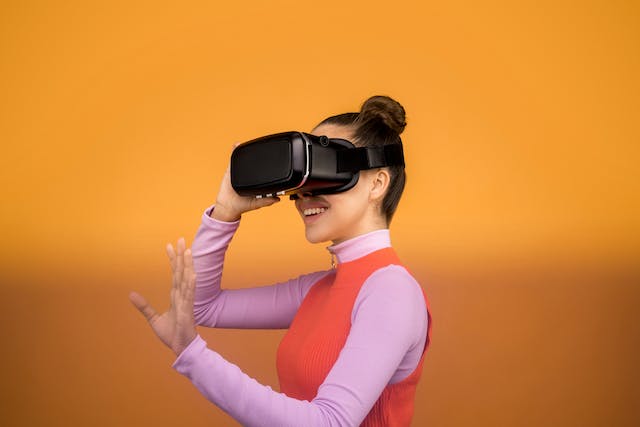Theme:
- The launch of the Apple Vision Pro headset has sparked discussions among people about the future of VR in everyday life.
What is Virtual Relaity (VR):
- Virtual Reality (VR) is a computer-generated world that you can see, hear, and sometimes even touch. When you wear special goggles or glasses, you feel like you’ve stepped into a whole new place, even though your body is still in the real world. It’s like going on an amazing adventure without leaving your room.
Future of VR in Everyday Life:
Here are a few examples of how virtual reality will seamlessly integrate into our daily lives.
- Virtual Reality can transport students to virtual classrooms, making learning more immersive and engaging. For instance, a geography lesson might involve students exploring the Great Barrier Reef or walking through the streets of Rome, providing a more tangible understanding of the subject matter.
- It has the potential to transform the entertainment landscape by bringing a cinematic experience directly to your home. Imagine being able to enjoy movies or shows as if you were in a theatre, all from the comfort of your living room. With VR, the traditional boundaries between the audience and the content can blur, making entertainment more interactive and immersive. The virtual environment created by VR technology allows users to feel like they are part of the action, enhancing the overall viewing experience. This innovation not only redefines how we consume entertainment but also opens up new possibilities for storytelling and engagement within the digital realm.
- It can revolutionize remote work by introducing virtual offices. In these digital spaces, colleagues can come together, collaborate, and hold meetings as if they were physically present, despite being geographically distant. This innovation could redefine the traditional work environment, offering a seamless and immersive way for teams to connect and work together without going to the office.
- Virtual Reality enhances healthcare accessibility by enabling remote medical consultations. It creates a convenient and accessible platform for medical assessments, making healthcare services more readily available to a broader population.
- Soldiers can practice various scenarios, such as combat situations, medical emergencies, or vehicle operations, in a safe and controlled virtual setting.
- VR social platforms could offer a sense of presence, allowing people to connect with friends and family regardless of physical distance to interact in a more personal way.
- Virtual Reality travel experiences have the potential to turn dreams into digital reality, enabling individuals to explore destinations they’ve always longed to visit. With the immersive power of VR, users can virtually step into iconic landmarks, wander through picturesque landscapes, and absorb the cultural richness of far-off places, all from the comfort of their homes. This innovative application of technology not only satisfies wanderlust but also opens up a world of possibilities for those who may face physical or logistical constraints in realizing their travel aspirations.
- VR training programs could revolutionize how we acquire and practice various skills, from cooking to professional development.
- VR shopping could recreate the in-store experience, allowing customers to virtually try on clothes or test products before purchasing.
- Virtual Reality therapy is like a special kind of treatment using advanced technology. In this, people wear special goggles and enter a virtual world that helps them deal with different problems, like stress or fears. It’s a bit like going on a virtual adventure to overcome challenges. For example, if someone is scared of heights, VR therapy can create a virtual scenario where they face heights in a safe way, helping them get used to it. It’s a cool way to use technology to make people feel better and conquer their fears.
Challenges:
- Prolonged use of VR may lead to discomfort, motion sickness, and eyestrain. Managing these physical side effects is crucial for widespread adoption.
- Not everyone may have easy access to VR technology due to its cost and hardware requirements. This could create a digital divide, limiting the benefits to certain demographics.
- As VR involves immersive experiences, concerns about the collection and use of personal data may arise. Safeguarding user privacy in virtual environments becomes paramount.
- Excessive use of VR, particularly in social applications, might lead to reduced face-to-face interactions, potentially contributing to social isolation and impacting real-world relationships.
- The interconnected nature of VR systems introduces cybersecurity challenges. Protecting virtual spaces from unauthorized access, data breaches, and malicious activities becomes crucial.
- VR content can sometimes replicate real-world scenarios, raising ethical concerns. Addressing issues related to violence, inappropriate content, or the potential misuse of VR technology is essential.
- The immersive nature of VR experiences may lead to addictive behaviour, affecting individuals’ daily routines and responsibilities if not properly regulated.
- Certain VR applications may discourage physical activity, contributing to a sedentary lifestyle. Balancing VR use with maintaining a healthy level of physical exercise is essential.
- With various VR platforms and technologies emerging, establishing industry standards and regulations becomes crucial for seamless integration and compatibility.
- Implementing VR in professional settings may require adjustments in work culture, training, and policies. Resistance to change and the learning curve could be potential challenges.
Conclusion:
The future of virtual reality in everyday life seems promising, with the potential to revolutionize how we work, learn, socialize, and experience the world around us. As technology advances, VR might become an integral part of our daily routines, enhancing various aspects of our lives in ways we never thought possible.
Photo by Sound On
Your Turn…
Do you think VR can become an integral part of our lives in the near future? Express your point of view on this topic through the comment section below. And subscribe to our blog to read answers to the trending GD topics.
Copyright @ Group Discussion Ideas.

